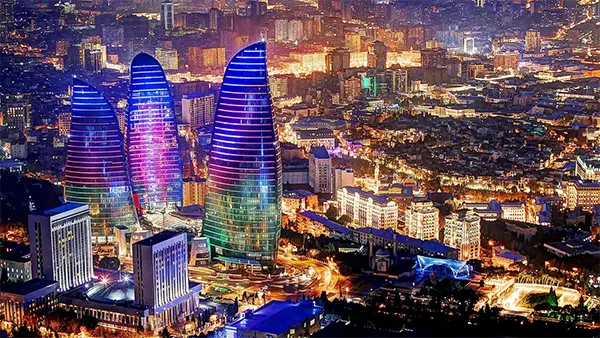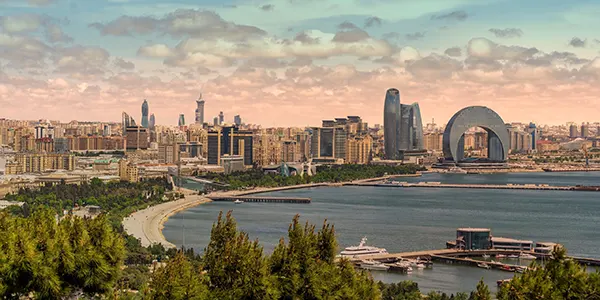Baku (Azerbaijan): Stone Past, Modernity and the Caspian Sea

The capital of Azerbaijan, Baku, stands where ancient stonework meets modern skylines, on the windy shores of the Caspian Sea. Once a fortress town along the Silk Road, today it’s a dynamic cultural hub combining mediaeval charm, energy-driven prosperity, and futuristic design. In 2025, Baku continues to balance its rich heritage with technological ambition, making it one of Eurasia’s most fascinating destinations.
The Historic Heart of Baku
The old city, Icherisheher, is a UNESCO World Heritage Site that has preserved its centuries-old walls, narrow alleys, and caravanserais. The Maiden Tower and the Shirvanshahs’ Palace remain at the core of Baku’s cultural identity, telling stories of merchants, poets, and conquerors who passed through its gates. Stone masonry and delicate oriental ornamentation remind visitors of Azerbaijan’s deep Persian and Turkic influences.
In recent years, restoration projects supported by both local historians and UNESCO experts have strengthened the city’s authenticity. Unlike many historical centres that become museum-like, Icherisheher is alive — filled with families, artisans, and small cafés serving aromatic Azerbaijani tea. It’s a place where modern life flows naturally around ancient stone walls.
Architecturally, Baku’s past blends Islamic, Caucasian, and Russian Empire aesthetics. You can trace its evolution from medieval defensive citadel to oil-rich capital through its restored mosques, ornate balconies, and Soviet-era courtyards. Each layer of architecture tells a part of Baku’s long story of adaptation and endurance.
Legends, Culture and Heritage
Folklore remains strong in Baku’s cultural life. The legend of the Maiden Tower, for instance, continues to inspire artists and filmmakers. Every spring, the Novruz holiday transforms the Old Town into a festival of fire and renewal, symbolising Azerbaijan’s connection to Zoroastrian traditions. Street musicians perform mugham — a classical Azerbaijani music style recognised by UNESCO as intangible heritage.
The city’s museums also play a crucial role in preserving national identity. The Azerbaijan National Museum of History and the Carpet Museum document the country’s transition from medieval khanates to a modern republic. The latter’s building, shaped like a rolled carpet, has become an architectural icon in itself.
For travellers, this concentration of living history makes Baku a unique place where one can sense the resilience of the people as much as the artistry of the stones. It’s a city that doesn’t freeze its past but interprets it anew for each generation.
The Modern Skyline and Innovation
Today’s Baku is known for its impressive skyline dominated by the Flame Towers, symbolising energy and progress. These glass giants overlook the Caspian coast, lighting up each evening with animations visible across the bay. Around them rise new business districts, modern housing complexes, and public parks designed to meet global environmental standards.
The city’s innovation extends to infrastructure. Electric public transport, expanding metro lines, and smart traffic systems have reshaped the way locals move through the metropolis. In 2025, Baku’s urban plan emphasises sustainable development — the use of wind power, solar lighting, and eco-friendly materials is increasing throughout the capital.
At the same time, Baku invests in cultural technology. Interactive museums and digital archives allow citizens and visitors to explore history through virtual reality, while educational centres promote technological literacy among youth. This synthesis of tradition and innovation defines modern Azerbaijan’s global identity.
Architecture that Connects Eras
Among the city’s architectural marvels, the Heydar Aliyev Centre, designed by the late Zaha Hadid, remains an emblem of fluid modernism. Its sweeping white curves reject rigid geometry, echoing the desert wind and waves of the Caspian. Inside, art exhibitions, concerts, and conferences reflect Baku’s international spirit.
Equally notable are the new eco-districts emerging in the suburbs. Residential projects integrate renewable energy systems, rooftop gardens, and public green corridors. The combination of glass, steel, and greenery symbolises Baku’s dedication to responsible progress.
By connecting its modern structures with historic silhouettes, Baku has avoided the dissonance that often appears in rapidly developing capitals. Instead, it presents an urban dialogue where every building — from medieval mosque to digital museum — contributes to one harmonious narrative.

The Caspian Shore and the Energy of Nature
The Caspian Sea defines Baku’s rhythm. Its winds — famously strong — have shaped the local architecture and even the city’s nickname, “City of Winds.” Along the coastline stretches the Baku Boulevard, a 26-kilometre promenade featuring gardens, cafés, and the national flag square, once among the tallest flagpoles in the world.
Energy, both natural and industrial, has always been at the heart of Baku. The oil boom of the 19th century transformed it into a global energy hub, and now the focus shifts toward renewables. Offshore wind farms and solar projects supported by international partnerships illustrate Azerbaijan’s long-term vision of balancing tradition with environmental awareness.
For locals, the sea is not only a source of livelihood but also identity. Fishermen, sailors, and engineers coexist along the same coast, demonstrating how Baku’s maritime culture continues to evolve in harmony with global sustainability goals.
Tourism, Hospitality and Future Vision
Tourism in 2025 is a strategic priority for Azerbaijan. Baku attracts visitors from Europe, the Middle East, and Central Asia thanks to improved air connections and simplified e-visa systems. New hotels and cultural centres have been designed to respect local aesthetics while providing international comfort standards.
Events such as the Baku Jazz Festival and Formula 1 Grand Prix continue to raise the city’s profile worldwide. Meanwhile, the government’s focus on responsible tourism encourages eco-trips to the Absheron Peninsula and nature reserves surrounding the capital. This approach ensures that growth benefits both visitors and residents.
Baku’s future vision rests on cultural diplomacy — showing the world that modern Azerbaijan stands for innovation, tolerance, and creativity. It’s a destination where the desert meets the sea, and where the rhythm of ancient stones resonates with the hum of modern life.
